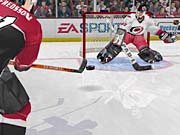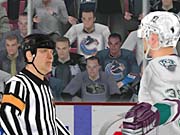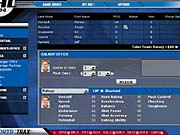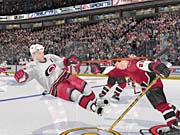It's as simple as this: If you play hockey on your PC, you play EA Sports' version of hockey. The last serious competition vanished years ago, bullied out of existence by the increasingly powerful, increasingly dominant EA juggernaut. Today, the NHL series is judged only against previous installments and the real-life sport. This year's iteration, NHL 2004, is one of the most interesting in quite some time, offering more innovations than most recent efforts and providing decidedly improved realism. Despite a few glitches--some which are quite glaring--the latest NHL is the finest, and certainly the most challenging, NHL to date, and it's a real step forward from last year's rather complacent NHL 2003.

Strictly from a gameplay standpoint, NHL 2004 represents a major turning point for the series. Gone are the unrealistically fast, stylish laser-beam passing and shooting drills of past editions. Those brilliant 10-pass relays culminating in light-speed one-timers to the top corner? They're very rare indeed. Instead, the development team, EA Black Box, has built a game based on today's NHL. As anyone who follows the sport will tell you, the National Hockey League is now a tight-checking affair where humungous, highly talented players battle tooth and nail with other humungous highly talented players for every inch of a too-small ice surface. To advance the puck through defenders, into the slot, and eventually on the net, gamers must use a combination of foresight, skillful gamepad manipulation, and plenty of hard, bruising work around the perimeter and along the boards.
Like it or not, this is the current state of affairs in the real world, and it is reflected in the game. Now, hooking and bumping and clutching are paramount. The battles along the boards are tenacious, prolonged, and, sometimes, just plain hurtful. Fortunately, skaters aren't the only players blessed with new and improved humanness. Black Box didn't forget the goaltenders either.
Depending on their level of competence, goalies will give up dangerous rebounds that may find their ways to an opponent's stick. They'll occasionally muff a save, by getting just a piece of the puck and letting it dribble in along the ice or by letting the puck bounce over their sticks and past their shoulders and into the net. Furthermore, they're forced to endure the probing sticks of enemy players, who realistically poke away at the puck even when it seems to be safely covered up. Unfortunately, the developer has not instituted any new goalie controls beyond "save," "pass," and "clear puck." A "smack upside the head" control would have been nice.
The kicker is that none of the above is easy. Although NHL 2004's easiest difficulty level still allows rookies to win their fair share of games just by using basic gamepad controls, all other levels require substantially more knowledge and practice than ever before.
As the commander and overlord of your team, you must make use of every button and button combination to prevail. Complex deking maneuvers, shot blocks, hooks, poke checks, body checks, an assortment of variable speed passes and shots, and precise positioning are the new weapons of NHL 2004. With judicious use of the right analog stick (presuming your controller is so equipped), you can even control the exact direction of your check or body check so you don't miss your desired target. In fact, if you don't master this new option--deemed "bruise control"--throwing a solid hit is almost inordinately difficult.
The truth is that fans of arcade-style wham-bam hockey may never warm up to the new challenges. Certainly they won't be happy to know that Black Box has altered the user control set so that the "speed burst" and "body check" actions are now activated by separate buttons, hence making those monstrously crushing body blows of the past nearly impossible. However, hardcore players willing to put in lots of practice time should come to love the significantly altered new approach.
Black Box has also rid the game of some its more annoying foibles. For example, you can no longer count on your AI-controlled opposition to consistently flub their breakaway opportunities. More often than not, a breakaway will result in a goal. You can now no longer complete a successful pass unless the intended recipient is oriented to the puck carrier and is free of nearby rivals. You can't delay an outlet pass from the defensive zone and expect your target player to prevent a two-line offside call by magically tap dancing just inches from the center line. And, thankfully, the only time you'll see an AI goalie freeze the puck for a play stoppage is when you've completely cut off all opportunities to clear it.

Still, some problems remain. On more than one occasion we've been hung out to dry by a goalie who meandered behind his net and became stuck there, somehow unable to return to his proper position until the next whistle. We experienced several phantom offside calls and were none too pleased to discover that the most effective defensive technique still involves hammering opponents to the ice illegally, even if they aren't carrying the puck. Sadly, the one big problem hampering every NHL upgrade to date has not been wholly rectified. As in past versions, the latest game leaves you with the feeling that the programming code exerts too much control over which scoring opportunities are successful, which are not, and, sometimes, which team will eventually prevail. Furthermore, the software seems to go to exaggerated lengths to ensure a close, exciting finish.
Indeed, we were surprised at the number of times we were able to tie a close game in the last few seconds on a seemingly feeble shot and were then able to win it on another easy shot in overtime. We were also surprised at the ease with which our AI opponents scored three or four late goals in the span of just a couple of minutes to knot an otherwise one-sided contest. Proven goal scorers hitting the post of a wide-open cage from point blank range and massive shot advantages that don't pan out on the scoreboard are things that just don't happen in the real world. It is clear that the game engine attempts to duplicate the sense of good or bad luck and emotional swings that permeate many NHL games, but the execution leaves something to be desired. Happily, the frequency of these predetermined instances has decreased enough so that gameplay is generally a positive experience.
NHL's graphics remain, for the most part, as they were in last year's model. In other words, the game looks as superb as ever but not appreciably enhanced. The most notable exception is the depiction of the crowd. In prior iterations, spectators were portrayed as either 2D cutouts or squared swatches of color. This time around, each little fan is a mobile and fully reactive 3D entity. Granted, there are probably only a dozen or so distinct entities strewn throughout each building, each replicated many times over to fill the stadium, but the overall impression is superb. It is a wondrous thing to watch thousands of these little performers, many of whom are decked out in hometown jerseys, jumping from their seats or throwing their hands in the air to celebrate a goal or a win.

This year, the game features nearly 100 total teams, including 30 from the NHL, 20 from the world class international level, 40 from Europe's pro leagues, and several all-star squads. That's a lot of teams, especially considering that each is stocked with more than 20 digitally re-created, motion-captured, structurally correct representations of real-life players. And now, these players look better than ever.
Rather than focusing on intimate player detail, facial expressions, and other processing-intensive elements most users won't even see during the course of a game, Black Box has clearly directed its efforts on general animations. The results are stunning. Now, when you direct your player to perform a given action, he'll do so with a unique set of miniscule movements unique to the given situation. Turn your skater quickly, and he'll perform the same series of maneuvers a real player would do in the same circumstances. He'll snowplow to a stop, throwing up a shower of ice shards in the process, and forcibly push his body in the opposite direction. You'll actually see his midtorso moving first, then his legs, and finally his arms. This sort of authenticity is evident from start to finish.
Off the ice, NHL offers the same massive array of options and settings we've all come to expect from most top-drawer EA Sports titles. In essence, the game can be just about anything you want it to be. If you don't like the rules, you can change them. If you can't handle the speed, you can reduce it. If you want to play a one-off exhibition between two mediocre European teams or a full season of NHL play, you can do that too. And if you want to create a superhuman powerhouse player who can shoot the lights out from 100 yards away and toss aside opponents with a mere shrug of his enormous shoulders, go ahead and create him.
However, one thing you haven't been able to do in the past is conduct a career. In NHL 2004, you can. EA deems it "Dynasty," and it is quite fantastic. In dynasty mode, you control virtually every aspect of your chosen team's operation, right on down to salary negotiations and ticket prices. You decide if you want to put your squad through another laborious practice on the next nongame day. You decide if you want to give them a well-deserved break. You decide who to dress, who to scratch, who to trade, who to draft, and who to send down to the farm. The ramifications of your decisions are many. Happy players, making a good wage and on the verge of a potential salary increase, tend to play very well indeed, but they will cost a pretty penny to keep around for the next year. Poorly performing teams may benefit from more practices, or they'll grow tired and disillusioned. Wins are good for everything, including your fan-base and attendance figures.
The better you do, the sooner you acquire upgrade points, which may then be allocated toward critical aspects, like scouting or medical staffs. Even when things appear to be going swimmingly, you must remain aware of potential trouble, like fatigued players who are risking injury, declining revenue due to high salaries, and much more. To make matters even more interesting, the other GMs are a smart bunch who draft intelligently and won't accept bogus trade offers. One word of warning: A season of dynasty hockey is permanently set at 82 games, and, therefore, involves a lot of time and effort--unless you ask the program to simulate your results.
Aside from one rather frustrating bug, NHL 2004's audio is as solid as it has always been. The musical score is standard EA Sports fare--lots of loud raucous nu-metal and rap rock. Rowdy young folk will eat it up, but many will ultimately turn it down or switch it off, particularly after they've heard everything three or four times--which won't take much more than a few hours.
The game's sound effects are typically stellar. They encompass everything from surround sound crowd chants to air horns, from various reverberating stick-on-puck whacks to swooshing shot follow-throughs, from thumping body checks to a wide range of oofs and ughs, and much more. While all of the above is fine and dandy, the announcing is anything but.
It's not the quality of the announcing tandem that's the problem. Returning for yet another go is NHL play-by-play stalwart, and superb real-life hockey broadcaster, Jim Hughson, who sounds as great as ever. Joining Hughson this time is ex-player, and current television hockey analyst, Craig Simpson, who sits in the color commentator chair occupied by Don Taylor during the last two seasons. Taylor, a funny guy and excellent sports anchor in real life, was a breath of fresh air in NHL 2002 but suffered from an inane script in NHL 2003. Simpson, considerably more restrained than Taylor, nevertheless delivers his somewhat dreary script well and does not hamper the proceedings.

No, the real irritation here is the sheer number of times these guys are wrong. They'll plead for the teams to "open it up" when the score is already 5-to-5. They'll rave about a goaltender's shutout when said goalie is not, in fact, brandishing a shutout. They'll refer to the game at hand as an exhibition contest when it's, in fact, a regular season or dynasty game. You're likely to experience this sort of blatant error at least once or twice per game, and that's not acceptable.
Neither are online glitches. Like previous installments, NHL 2004 supports a variety of multiplayer modes, including LAN, direct connection, Internet, and the comprehensive EA Sports Online paid service. The good news is that it runs quite smoothly online, exhibiting, satisfactorily, little lag and virtually no morphing. The bad news is that games tend to end prematurely. Of the half-dozen contests we played via EA Sports Online, we crashed out thrice, most often during the face-off routine, and usually after we'd gone deep into a given contest. In surveying other players, we found such problems were not at all atypical. Granted, EA will most likely address this issue in the near future, unfortunately that won't help those who are playing now.
Clearly, the deepest, toughest, and most authentic NHL to date, NHL 2004 seeks to recapture the hearts of those serious hockey fans who may have found it too action-oriented in the recent past. It is successful, for the most part, despite several question marks and problem spots. If you shied away, or were disappointed by last year's model, and are willing to accept an inevitable patch, this is the year to get back in the game.